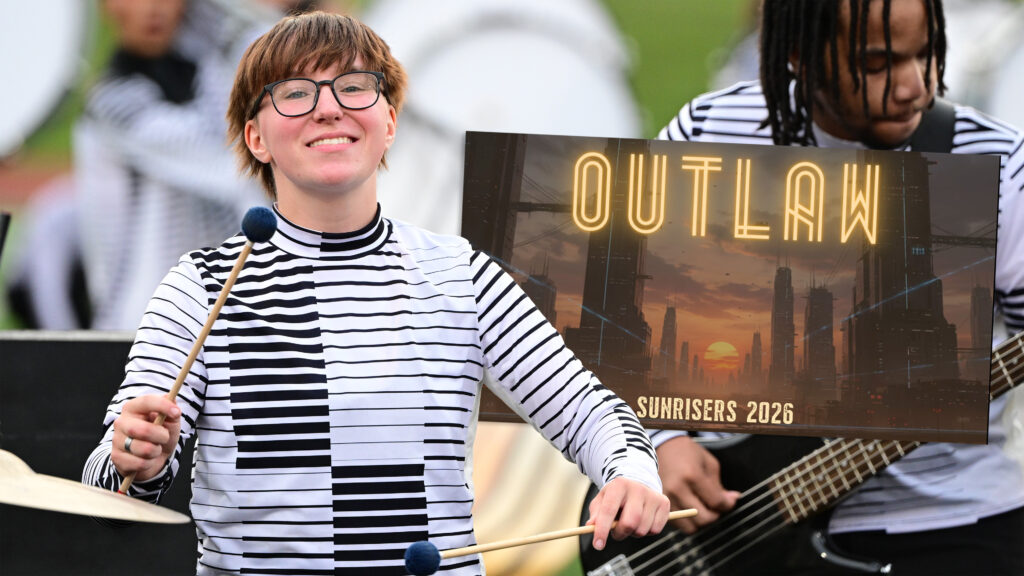2009 marked the second year that the DCI Open Class World Championships headed to Ames Field in Michigan City, Indiana.
Though all Open Class World Championship shows were held in Michigan City between 2011 and 2018, just the Open Class Quarterfinals competition came to the city on the shore of Lake Michigan in 2009 and 2010. For those two years, all corps moved on to Indianapolis for the Open Class Semifinals and Finals.
Blue Devils B won all three Open Class events on the basis of capturing both general effect captions and all three visual captions, joining the World Class Blue Devils in enjoying an undefeated season. Vanguard Cadets finished second, just eight tenths of a point underneath the Devils.
Citations placed third for the corps’ highest finish ever, largely on the basis of winning the Color Guard caption by an astounding 1.80 points over the next highest guard. Teal Sound, in fourth place, prominently featured a rock band throughout its show. Fifth place Capital Regiment returned to the Finals after being inactive the prior two years, and in ninth place the Velvet Knights returned to the Finals after falling out in 2009. Combined with Citations and the 10th-place Legends making Finals for the first time, one-third of 2009’s Open Class finalists weren’t in the big show the year before.

“Incrementum,” the title of Legends’ show, is a Latin word referring to growth and development, appropriate for a corps that had existed since 2006 but didn’t attend the DCI World Championships its first two years. The Kalamazoo, Michigan group finished 15th at the Open Class Semifinals in 2008, and finally earned a spot in the Top 12 in 2009.
The corps based its show entirely on the atmospherically delicate strains of Maurice Ravel’s French Impressionistic “Suite No. 2” from “Daphnis et Chloé,” extracted from a ballet the composer had yet to complete. Sergei Diaghilev, the same impresario who commissioned Igor Stravinsky to write ballet music for “The Firebird,” Petrouchka,” and “The Rite of Spring,” commissioned Ravel to compose “Daphnis et Chloé” for a world premiere by his famed Ballet Russes company.
“Daphnis et Chloé” is based on a pastoral love story drama about goatherd Daphnis and shepherdess Chloé, written by the Greek poet Longus sometime around the second Century AD. The music is rarely performed as a ballet and is better known in the form of two suites Ravel completed a year before the ballet’s 1912 premiere. Legends’ performance of “Suite No. 2” utilized the music best known by concert orchestra audiences; being that “Suite No. 1” is seldom performed.
Legends’ 25 horns and percussion treated the music of “Daphnis and Chloé” with extreme tastefulness, starting with brass players and color guard members bending over while kneeling, faces to the ground. The rolled low register sounds of marimbas wafted over the field during the show’s introduction, horn players and guard members with arms outstretched prior to standing up.
The upper brass faced backfield to present the opening strains, a lone trumpet soloist gently playing to the audience. Ravel portrayed the courtship of the two title characters in the first two scenes of music; however, the corps intentionally did not present a storyline.
The music didn’t get loud until about a minute and-a-half into the show when the seven members of the color guard picked up solid black flags.

The second part of the production started with thunderous percussion introducing the music of Chloé being abducted by and escaping from a band of pirates.
Three bright yellow flags accompanied the rest of the color guard with sabers, with all moving to flags when the music reached its climax. The movement ended with a guard member gracefully presenting herself wearing butterfly wings of a stained-glass nature.
The following movement utilized Ravel’s music that described birdcalls and the murmuring of a brook at daybreak, with undulating orchestral instruments in the original and lightly floating brass motifs on the field inferring those references to nature. The rest of the guard unveiled butterfly wing costumes, each picking up a solid white flag as the first performer did at the start of the movement.
The remainder of the show featured the climactic “Danse générale,” Ravel’s most popular movement from his “Suite No. 2.” In the ballet, the two lovers were reunited in the grotto of the half-human-half-goat god Pan, who had earlier helped save Chloé from the pirates. Ravel’s music intensified into a wild party of bacchanalian glee, accompanied on the field with golden flags.
Fans knew the cauldron must have been boiling under all the beauty that preceded the final movement, and when it bubbled over, the small horn line demonstrated it had been holding back on releasing its capability to deliver a degree of power unexpected for its size.
Just one year later in 2010, Legends moved up to eighth place in the Open Class Finals and would average that placement over the next four years. After a fifth-place finish in 2015, the corps finished third the next two seasons, quickly establishing itself as one of DCI’s top Open Class corps.

Michael Boo was a member of the Cavaliers from 1975-1977. He has written about the drum corps activity for more than 35 years and serves as a staff writer for various Drum Corps International projects. Boo has written for numerous other publications and has published an honors-winning book on the history of figure skating. As an accomplished composer, Boo holds a bachelor's degree in music education and a master's degree in music theory and composition. He resides in Chesterton, Indiana.





